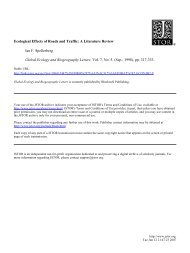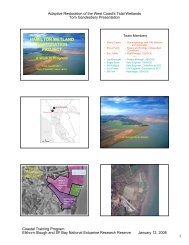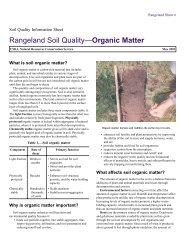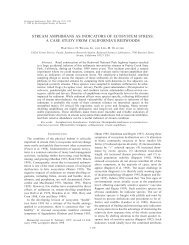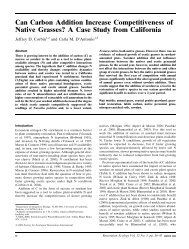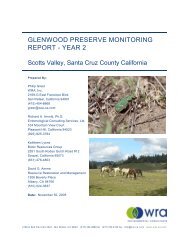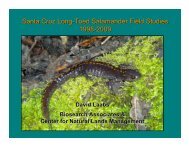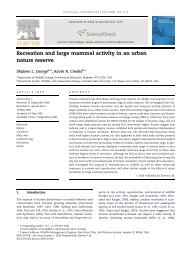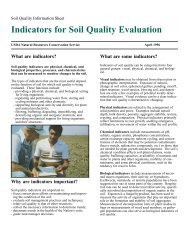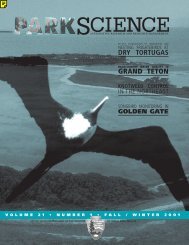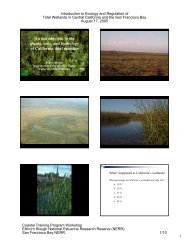ROBERT L. WILKERSON AND RODNEY B. SIEGELrather they occupied a variety of relatively aridhabitats including brushland, desert scrub, andnatural grasslands, and appear to be clusteredon the outskirts of urban development.Large confidence intervals make comparingour statewide population estimate with that ofDeSante et al. (2007) during 1991-1993 difficult,especially since the difference in the estimates isrelatively small. Three quarters of owl pairs inour aggregated population estimate reside in thedensely occupied Imperial Valley, where thestandard error associated with our regionalestimate is well over 2,000 pairs. Thus, the lackof precision in this single regional estimatecould easily mask a real statewide decline, or forthat matter, potentially even obscure a statewideincrease. Future survey efforts could perhapsminimize the problem of low statistical powerby focusing monitoring efforts on smaller areasselected for high owl population density orother factors, and sustaining those efforts formultiple successive breeding seasons.Our survey of the “new” survey regionscovering the Modoc Plateau/Great Basin,Mojave Desert, and Sonoran Deserts representsthe first systematic survey of Burrowing Owlsacross vast portions of California. We foundBurrowing Owls to be distributed heterogeneouslyamong these regions, with few or noowls in the Modoc Plateau/Great Basin, NorthernMojave/Eastern Sierra Nevada, EasternMojave, or Sonoran Desert regions (excludingthe Palo Verde Valley). However, we found muchlarger aggregations of burrowing Owls in theWestern Mojave region, and in one small area ofthe Sonoran Desert—the Palo Verde Valley.CONSERVATION IMPLICATIONSA comprehensive conservation strategy forBurrowing Owl in California is underdevelopment by California Department of Fishand Game and its partners (Burkett andJohnson, 2008). Here we provide a fewconservation-related conclusions and recommendationsthat stem directly from our results:1) Despite the apparent robustness of thepopulation in the Imperial Valley, smallerpopulations elsewhere in the state, particularlyin and near urban areas, appear to havecontinued to decline since the 1991-1993 survey.2) The vast majority of the state’s breedingBurrowing Owls continue to nest on privatelands; any meaningful conservation efforts musttherefore engage private stakeholders.3) Across much of California, Burrowing Owlnesting remains closely associated with thepresence of ground squirrels, another factor thatmust be considered in developing successfulconservation measures.4) In a few key areas, particularly theImperial Valley and the Palo Verde Valley,Burrowing Owls are not closely associated withground squirrels, and instead rely heavily on thebanks of concrete and earthen water conveyancestructures for nesting sites. Comprehensiveconservation planning for Burrowing Owl inCalifornia must take into consideration theimportance of these artificial structures.5) Although Burrowing Owl detections werescarce across most of the land area of the newlysurveyed Modoc Plateau/Great Basin andsouthern California desert regions, substantialpopulations persist in the Sonoran Desert (PaloVerde Valley) and the western Mojave Desertregions (particularly in and around theAntelope, Apple, and Lucerne valleys). Weestimate the western Mojave Desert region tocontain ~6% of California’s breeding BurrowingOwls, superseded in numerical importance tothe statewide population only by the ImperialValley and the Southern Central Valley regions.Successful conservation planning for this speciesmust address the particular needs of these substantialdesert populations (Wilkerson andSiegel, in press).6) A statewide conservation strategy willlikely need to incorporate a statewidemonitoring program to assess the effectivenessof conservation measures. Our study demonstratesthe potential value of citizen-scienceparticipation in single-species studies, particularlyof raptors or other highly charismaticspecies like Burrowing Owls that are relativelyeasy to find and identify. While many of ourvolunteer observers were highly skilled birders,and in some cases, even wildlife professionals,others had little or no birding experience. With afairly modest investment of time and money forrecruiting, training, and supporting volunteersurveyors, we were able to extend our surveyacross a vast area. Engaging citizen-scientists inmonitoring could reduce the cost and extend thescope of any owl monitoring project, and mayalso yield less tangible benefits — participants in[32]
DISTRIBUTION AND ABUNDANCE OF BURROWING OWLS IN CALIFORNIAcitizen science monitoring programs can reap anincreased awareness and appreciation of study<strong>org</strong>anisms and their habitats, which may thentranslate into tangible actions on their behalf(Evans et al. 2005).ACKNOWLEDGMENTSThis project was made possible by funding fromthe National Fish and Wildlife Foundation,California Department of Fish and Game, PacificGas and Electric Company, and an anonymousdonor. We thank Esther Burkett at CaliforniaDepartment of Fish and Game for supportingthis project in numerous ways, David DeSante atThe Institute for Bird Populations for sharing hisknowledge and providing survey advice, andJim Saracco at The Institute for Bird Populationsfor statistical advice. Sue Townsend and DavidAinley provided helpful comments on themanuscript. We thank the ESRI ConservationProgram for software support.We thank the following individuals forserving as volunteer coordinators for theircounties or areas in 2006, in 2007, or in bothyears: Marie Barrett, Rich Cimino, Chris Conard,Jeff Davis, Jimm Edgar, Mike Fisher, DawnGarcia, Dan Guthrie, Darrell Hutchinson, CherylJohnson, Robin Leong, Krista Maney, JessicaMartini, Catherine Portman, Tom Ryan, DebraShearwater, Ginny Short, Ian Taylor, RuthTroetschler, Dave Wagner, and Carie Wingert.Other individuals who did not serve ascoordinators but nevertheless contributedsubstantial local information and/or logistichelp included Roger Higson (Palo Verde Valley)and Ryan Young (Antelope Valley).We are especially grateful to the followingvolunteers for participating in the survey of oneor more survey blocks: Jennifer Albright, ChrisAlderete, Diana Alleman, Lisa Allen, RussellAlmaraz, Jerry W. Ambrose, Mary AnnAmbrose, Sundeep Amin, Chloe Anderson,Simon Avery, Joellyn Avery, Patricia Bacchetti,Jason Bachiero, Valerie Baldwin, Jack Barclay,Marie Barrett, Margaret Barson, Peggy Bartels,Candice Basham, Jeff Beauchamp, David Bell,Joyce Bender, Judy Bendix, Debbie Benham, VernBenhart, Nicola Bennert, Josh Bennett, MurrayBerner, Linda Bernhart, Milton Blatt, DianeBodwin, Anita K. Booth, Brian Botham, DawnBradley, Steve Brady, Tricia Bratcher, TheresaBrennan, Craig Breon, Beverly Brock, Charles R.Brown, Philip Brown, Debbi Brusco, JulieBryson, Virginia Buchholz, Maureen BuffingtonSanto, Cheri Buskirk, Dotty Calabrese, KarleneCampo, David Carr, Chuck Carroll, RandiCassellius, Joyce Chang, Tony Chapelle, SophieChiang, David Chilton, Kirsten Christopherson,Jeff Church, Rich Cimino, Mareyn Clements,Richard Clements, Neil Clipperton, Wendy Cole,Barbara Coley, Roger Coley, James M. Collier,Judith A. Collier, Chris Conard, David Cook,Daniel S. Cooper, Curt Cotner, Erica Craven,Anne Crealock, Lori Cuesta, Cindy Curtis, KenCurtis, Kirsten Dahl, Virginia L. Dallas-Dull,Larry Davidson, Jeff N. Davis, Karen DeMello,Susan Dieterich, Joan Dodson, Jim Dodson, JedDouglas, Peter Drumer, Doug Drynan, JimDunn, Natasha Dvorak, R. Eckland, Jimm Edgar,Arthur L. Edwards, Linda Edwards, LornaElness, Mark Elness, Madi Elsea, Kevin Enus-Rempel, Laura Erickson, Janeann Erickson, JakeEstis, Mary Fajekers, Jonathan Feenstra, StaceyFeigekonwiesr, Hank Feilen, Jane Fielder, MeganFisher, Mike Fisher, Tim Fitzer, Kasey Foley, JoelForty, Bennie Fouch, Scott Frazer, LindaFreeman, Mary Freeman, Nick Freeman, ParkerFritch, Lillian Fuji, Harold Fukuma, Barry Furst,Dawn Garcia, Melisa Garcia, Maureen Geiger,Harriet Gerson, Brian Gibson, Neil Gilbert,Steven Glover, Dave Goodward, Debbie Green,John F. Green, Richard Greene, Linda Greene,Christina Greutink, Dan Guthrie, SamanthaHafter, Portia Halbert, Catherine Halley, DevonHammond, Lindsay Harman, KristeyHarrington, Carmen Hashagen, Ken Hashagen,Cole Hawkins, Priscilla Hawkins, Steve Hayashi,Ursula Heffernon, Lynn Hemink, J. Herman,Philip Higgins, Jon Hilbert, Carolyn Hinshaw,Allan Hollander, Lindsay Holt, Amber Holt,Kathryn Hood, Scott Huber, Liam Huber, SherryHudson, Bobby Huss, Darrell Hutchinson,Meighan Jackson, Sue James, Tim Jenkins, PhilJohnson, Vernon Johnson, Dave Johnston,Jennifer Jones, Douglas Joo, Linda Jordan, GinnyKaminski, Jerry Kaminski, Martin Karsch, LolaKashyap, Maral Kasparian, Guy Kay, DavidKeeling, Elena Keeling, Mary Keitelman, LazanKeitelman, Ruth Kennedy, Stephen King, JudyKlink, Oliver Klink, Joanna Koob, Eva Kristofik,Nathan Krumm, Tim LaFlame, Kimya Lambert,Aleatha W. Landry, Steve Laymon, CathieLaZier, Rod Lee, Sara Lee, Lora Leerskov, Robin[33]
- Page 1 and 2: BIRD POPULATIONSA journal of global
- Page 3 and 4: BIRD POPULATIONSA journal of global
- Page 6 and 7: ROBERT L. WILKERSON AND RODNEY B. S
- Page 8 and 9: ROBERT L. WILKERSON AND RODNEY B. S
- Page 10 and 11: ROBERT L. WILKERSON AND RODNEY B. S
- Page 12 and 13: ROBERT L. WILKERSON AND RODNEY B. S
- Page 14 and 15: ROBERT L. WILKERSON AND RODNEY B. S
- Page 16 and 17: ROBERT L. WILKERSON AND RODNEY B. S
- Page 18 and 19: ROBERT L. WILKERSON AND RODNEY B. S
- Page 20 and 21: ROBERT L. WILKERSON AND RODNEY B. S
- Page 22 and 23: ROBERT L. WILKERSON AND RODNEY B. S
- Page 24 and 25: ROBERT L. WILKERSON AND RODNEY B. S
- Page 26 and 27: ROBERT L. WILKERSON AND RODNEY B. S
- Page 28 and 29: ROBERT L. WILKERSON AND RODNEY B. S
- Page 30 and 31: ROBERT L. WILKERSON AND RODNEY B. S
- Page 32 and 33: ROBERT L. WILKERSON AND RODNEY B. S
- Page 36 and 37: ROBERT L. WILKERSON AND RODNEY B. S
- Page 38 and 39: ROBERT L. WILKERSON AND RODNEY B. S
- Page 40 and 41: NIRANJAN DAS AND SUJATA DEORIincluy
- Page 42 and 43: NIRANJAN DAS AND SUJATA DEORIprovid
- Page 44 and 45: NIRANJAN DAS AND SUJATA DEORIpopula
- Page 46 and 47: NIRANJAN DAS AND SUJATA DEORITABLE
- Page 48 and 49: NIRANJAN DAS AND SUJATA DEORITABLE
- Page 50 and 51: NIRANJAN DAS AND SUJATA DEORITABLE
- Page 52 and 53: NIRANJAN DAS AND SUJATA DEORITABLE
- Page 54 and 55: NIRANJAN DAS AND SUJATA DEORITABLE
- Page 56 and 57: NIRANJAN DAS AND SUJATA DEORITABLE
- Page 58 and 59: Bird Populations 10:56-64© The Ins
- Page 60 and 61: WETLAND BIRDS OF GHANAAvicennia afr
- Page 62 and 63: WETLAND BIRDS OF GHANATABLE 1. Data
- Page 64 and 65: WETLAND BIRDS OF GHANATABLE 2: Esti
- Page 66 and 67: WETLAND BIRDS OF GHANAATTUQUAYEFIO,
- Page 68 and 69: JANNIK HANSEN, LARS HOLST HANSEN, N
- Page 70 and 71: JANNIK HANSEN, LARS HOLST HANSEN, N
- Page 72 and 73: JANNIK HANSEN, LARS HOLST HANSEN, N
- Page 74 and 75: JANNIK HANSEN, LARS HOLST HANSEN, N
- Page 76 and 77: JANNIK HANSEN, LARS HOLST HANSEN, N
- Page 78 and 79: JANNIK HANSEN, LARS HOLST HANSEN, N
- Page 80 and 81: JANNIK HANSEN, LARS HOLST HANSEN, N
- Page 82 and 83: JANNIK HANSEN, LARS HOLST HANSEN, N
- Page 84 and 85:
JANNIK HANSEN, LARS HOLST HANSEN, N
- Page 86 and 87:
JANNIK HANSEN, LARS HOLST HANSEN, N
- Page 88 and 89:
JANNIK HANSEN, LARS HOLST HANSEN, N
- Page 90 and 91:
BIRD POPULATIONSA journal of global
- Page 92 and 93:
Bird Populations 10:90-109© The In
- Page 94 and 95:
DAVID J. ZIOLKOWSKI JR., KEITH L. P
- Page 96 and 97:
DAVID J. ZIOLKOWSKI JR., KEITH L. P
- Page 98 and 99:
DAVID J. ZIOLKOWSKI JR., KEITH L. P
- Page 100 and 101:
DAVID J. ZIOLKOWSKI JR., KEITH L. P
- Page 102 and 103:
DAVID J. ZIOLKOWSKI JR., KEITH L. P
- Page 104 and 105:
DAVID J. ZIOLKOWSKI JR., KEITH L. P
- Page 106 and 107:
DAVID J. ZIOLKOWSKI JR., KEITH L. P
- Page 108 and 109:
DAVID J. ZIOLKOWSKI JR., KEITH L. P
- Page 110 and 111:
DAVID J. ZIOLKOWSKI JR., KEITH L. P
- Page 112 and 113:
Bird Populations 10:110-113© The I
- Page 114 and 115:
THE 2007 AND 2008 NORTH AMERICAN BR
- Page 116 and 117:
Bird Populations 10:114-124© The I
- Page 118 and 119:
BREEDING BIRD CENSUS: 2007on the pl
- Page 120 and 121:
BREEDING BIRD CENSUS: 2007May, with
- Page 122 and 123:
BREEDING BIRD CENSUS: 2007Remarks:
- Page 124 and 125:
BREEDING BIRD CENSUS: 200717. PITCH
- Page 126 and 127:
BREEDING BIRD CENSUS: 2007+; Wester
- Page 128 and 129:
BREEDING BIRD CENSUS: 2008gray Gnat
- Page 130 and 131:
BREEDING BIRD CENSUS: 2008Warbler,
- Page 132 and 133:
BREEDING BIRD CENSUS: 2008Source: W
- Page 134 and 135:
BREEDING BIRD CENSUS: 2008Spotted T
- Page 136 and 137:
BREEDING BIRD CENSUS: 2008precipita
- Page 138 and 139:
Bird Populations 10© The Institute
- Page 140 and 141:
IS AVIAN BREEDING SUCCESS WEATHERIN
- Page 142 and 143:
IS AVIAN BREEDING SUCCESS WEATHERIN
- Page 144 and 145:
DAVE LEECH AND CARL BARIMOREFlycatc
- Page 146 and 147:
Bird Populations 10:143-145Reprinte
- Page 148 and 149:
WOODPIGEON JOINS THE GARDEN PREMIER
- Page 150 and 151:
CHANGING THE GUARD AT UK BIRDTABLES
- Page 152 and 153:
Bird Populations is an entirely ele
- Page 154:
BIRD POPULATIONSA journal of global



